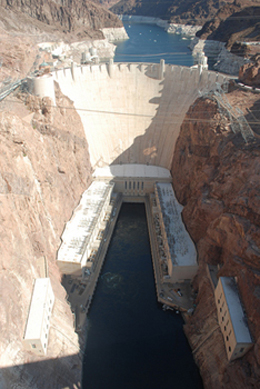
So big and strong, yet beautifully graceful is Hoover Dam that it stands as an American icon, a symbol of a nation’s strength, ingenuity, and spirit of enterprise. But unlike many other of the nation’s icons, be they Mount Rushmore or the Washington Monument, Hoover Dam was built, above all else, to be useful, to store water for irrigation, for municipal supplies, and to create hydroelectric power. That is what modern dams do in the American West. How they came to be built is the story of the Bureau of Reclamation, but the story of dams is as old as human civilization. The ancient Egyptians and Romans built dams, as did native people in the Americas. While the way dams are constructed has evolved with human knowledge and technology, basic traditions of design and function remain unchanged.
In functional terms, as historian Donald C. Jackson writes, dams fall into two categories: diversion dams and storage dams. Diversion dams, as their name implies, divert water from a stream or river, through a canal or conduit to another place where it is needed. In Nevada, for instance, Derby Diversion Dam diverts water from the Truckee River through a canal to irrigate land farther south, in the Lahontan Valley. Storage dams retain water for long-term use in the reservoirs they create. Hoover Dam, for instance, is a storage dam; Lake Mead its reservoir.
When it comes to design, two basic traditions reign: the massive tradition and the structural tradition. Dams in the massive tradition depend on their weight to hold back water, while dams in the structural tradition depend on their shape. Those depending on weight are known as gravity dams because their weight pulls down on the dam, offering resistance to the pressure exerted by the water stored behind them. Dams depending on their shape are either arch dams or buttress dams. Arch dams are built in narrow canyons with solid walls because the walls help carry the weight of the water, pushing back and squeezing the concrete in the arch, making the dam rigid. Buttress dams generally are built in wide valleys and depend on several buttresses for support. Arch dams, because they do not depend on sheer bulk, generally require less material to build, and thus are less expensive than gravity dams.
In the United States, dam building received little attention until the Great Flood of 1889, which killed 2,209 people when the South Fork Dam collapsed, 14 miles upstream from Johnstown, Pennsylvania. The disaster, memorialized at the National Park Service’s Johnston Flood National Memorial, occurred at a time when American cities were growing and the new electric light industry was taking root. North of New York City, engineers began building Croton Dam in 1892 to supply growing water needs. Unlike South Fork Dam, which was an earth embankment dam impounding a recreational lake, Croton Dam was a masonry gravity dam, which was standard for municipal storage dams at the time. (Masonry can mean brick, stone, or concrete, bound together by mortar.) When completed in 1906 at 297 feet high, Croton Dam was the tallest in the world. In the late 19th century, slender arch dams were so unusual that the 64-foot-high Bear Valley Dam, built in California in 1884, was considered a wonder--a wonder because it didn’t crack in two. A gravity dam like Croton seemed so much safer.

People have built dams for thousands of years, including the Romans’ famous arch dams, but it wasn’t until the 18th century that engineers in Spain began to use mathematical formulas to calculate dimensions while designing dams. In 1736, the first book on how to design dams, written by a Basque nobleman, appeared. Engineers in France and England added to knowledge by publishing essays in the late 18th and early 19th centuries. As Jackson explains, an engineer in the 1850s figured out how much masonry was needed to make a gravity dam safe if it were to impound a certain amount of water. This could be done by calculating the horizontal pressure of the water pushing on the dam and the vertical pressure exerted by the weight of the mass itself. One needed to understand that pressure always was greatest at the base of the dam. The key was to make sure the force fell within the middle third of the dam’s cross-section; if that happened, the dam would not slide away or tip over.
In the United States, passage of the Reclamation Act of 1902, which created the U.S. Reclamation Service (now the Bureau of Reclamation), pushed dam building forward and put the nation on track to become the preeminent dam builder in the world. The Reclamation Act, intended to help open the American West to settlement, committed the Federal Government to construct permanent works--dams, reservoirs, and canals--to irrigate arid and semiarid lands in 16 western states and territories (the 17th state, Texas, was added in 1906).
As the neophyte Reclamation Service began building its first big dams, discussion of gravity dams vs. arch dams--mass vs. form--was front and center. But the American West was a special case. As engineer George Y. Wisner argued, the region was so arid that its dams needed to be of great height if reservoirs were going to be able to store adequate water to meet needs. But the higher the dam and the more water stored behind it meant, of course, greater pressure on the dam. In 1905, a contract was let for one of Reclamation’s first large dams--Pathfinder, to be built on Wyoming’s North Platte River, near its confluence with the Sweetwater. Wisner, and fellow engineer E. T. Wheeler, were selected to design it. An arch dam made sense because the North Platte ran through a steep, narrow canyon, perfect for an arch dam. But what of Wyoming’s high elevation and harsh weather? The thin upper arch needed extra protection, the engineers thought, or it might crack.
To deal with their concerns, Wisner and Wheeler designed an arch dam, but did something new by adding a gravity section. Pathfinder would function as an arch and gravity dam combined, distributing the load between horizontal arches and vertical cantilevers. This method, which they called the “Arch-and-Crown Cantilever Method,” was the predecessor of the Bureau of Reclamation’s “Trial Load Method,” which would be used later in the construction of dams as big and as famous as Hoover. The method, Norman Smith writes inMan and Water: A History of Hydro-Technology, “put arch dam design on a much sounder footing.”
Pathfinder Dam, completed in 1909, and its Wyoming neighbor, Buffalo Bill Dam, completed on the Shoshone River a year later, were at the forefront of these ideas as the new Reclamation Service got its feet wet. The two dams were the first to be analyzed using the Arch-and-Crown Cantilever Method. In these early years, as author David P. Billington writes, large dams appealed not only to designers like Wisner, but also to Reclamation’s top man, Frederick H. Newell. Newell wanted the West’s dams not only to appear safe, but also to serve as symbols of the Bureau of Reclamation’s ability “to accomplish great things.” At 325 feet high, Buffalo Bill Dam surpassed Croton Dam as the highest in the nation and was one of the first arch dams to be constructed, not of rock like the Pathfinder, but of mass concrete. Both dams, however, used the Cyclopean technique of carefully fitting huge, irregular stones together, which explains the rough face of Pathfinder Dam. At Buffalo Bill Dam, the method involved placing granite plum rocks in the concrete, ramming them into position, and then using the part that projected to bond the next layer of concrete. The granite plum stones reduced the amount of cement needed in the dam, thus reducing costs.
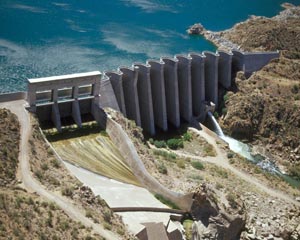
Also a forerunner was Theodore Roosevelt Dam, completed in 1911 on the Salt River, about 75 miles northeast of Phoenix. While it, like Pathfinder, is a masonry dam following the Cyclopean method, Roosevelt Dam is one the first of the Reclamation’s dams to produce hydroelectric power. Prior to the early 20th century, dams were built with one purpose in mind, either to irrigate fields, power mills, store a town’s water supply, or control flooding. But that changed with the growing demand for electricity.
While Thomas A. Edison invented the incandescent light bulb in 1879 and built the first electric powerplant in 1882, it was George Westinghouse who succeeded first in building a central power station that was able to transmit electricity over long distances. He did it by using the massive power of Niagara Falls to propel two, 5,000-horsepower, alternating-current generators housed in his Adams Powerplant Transformer House, which went online August 26, 1895. By 1901, with a full component of 10 generators in operation, Westinghouse proved the success of the venture by lighting the Pan-American Exposition in nearby Buffalo, New York. Today the Adams Power Transformer House is a National Historic Landmark, known as “the birthplace of the modern hydroelectric power station.”
President Theodore Roosevelt was in office less than a year when he signed the Reclamation Act of 1902 and put the Federal Government at the center of water issues in the American West. In 1903, as construction was set to begin on Arizona’s Roosevelt Dam, named in honor of the new president, small, hydroelectric generators were installed at the construction site to power the aerial cableway and other equipment needed to lift the huge dolomite blocks into place. Surplus power was sold to the community and, in 1909, a 4,500-kilowatt powerplant was constructed.
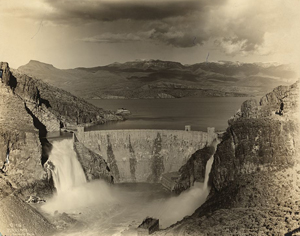
The notion to build dams to produce electricity, and not just to irrigate arid lands, would take time to gain acceptance. In fact, more than 20 years would elapse before the first great multipurpose dam, Hoover, got under way. In the meantime, Owyhee Dam went forward on the Owyhee River (pronounced oh-Y-hee) in eastern Oregon. Owyhee Dam, as Eric B. Kollgaard and Wallace L. Chadwick writes, was “a proving ground for theories being developed to assist with the design and construction of Hoover Dam,” which, at 726 feet, would stand nearly 300 feet higher than Owyhee. Engineers needed to know how concrete would act when poured in such massive quantities. What materials were needed? What methods of construction?
At Owyhee, where construction began in 1928, questions were answered. The system of cooling coils used in the construction of Hoover Dam, for instance, first was tested in a 28-square-foot concrete section at Owyhee. Because concrete, in hardening, creates great internal heat and expansion, engineers worried that subsequent cooling and contraction would create dangerous cracks in the interior of the dam. To solve the problem, Reclamation engineers experimented at Owyhee by funneling cool water through a network of 1-inch coils imbedded in concrete panels. Later, at Hoover Dam, the cooling system consisted of 590 miles of pipe loops circulating frigid water.
Tests also were conducted on Owyhee’s morning-glory spillway, a “daring design” at the time because few existed. Glory-hole, or morning-glory, spillways work like a giant drain, as swirling water drops through a vertical shaft and then discharges downstream through a tunnel. Owyhee’s spillway tunnel, and another completed at Gibson Dam in 1929 on the Sun River in Montana, were the first of the Reclamation’s dams to use such tunnels. Thermal property tests also were conducted at Gibson, which holds the distinction of being the first American dam not only to be analyzed according to the trial-load method, but designed using it.
The headlines, however, went to Hoover Dam, where construction began in 1931. President Franklin D. Roosevelt called it a “twentieth century marvel,” and Cadillac Desert author Marc Reisner writes of it as “perhaps the most significant structure that has ever been built in the United States.” Hoover Dam became an American icon, “a great symbol,” as David P. Billington writes, “of mankind’s ability to tame nature through technology and human effort.”
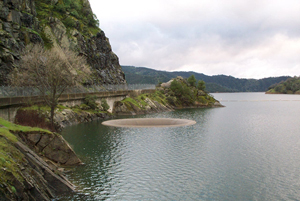
The dam was a major undertaking on a major river. The Colorado is one of the wildest in the country, dropping nearly 13,000 feet from its headwaters in the Colorado Rocky Mountains to its mouth in the Gulf of California. The sheer size of the dam, 726 feet high and 660 feet wide at its base, created new problems of design and construction that required intensive research. Models were created and tested. The type of cement to be used in such a massive structure was a big concern. Desiring a low-heat variety, tests were conducted on 49 commercial cements from around the country. Hoover Dam’s two spillways, so huge they each could float a battleship, presented challenges requiring new research and modeling before spillway design could process. Ultimately, Reclamation used the new ogee, or “S” shape crest design, as well as a better understanding of the sizing of stilling basins, which protect riverbeds from erosion by lessening the energy of fast-flowing water.
Hoover Dam continued to be a teacher as recently as 1983 when flood waters caused cavitation damage in its tunnel spillways, leading to new research and design innovation. Cavitation results when vapor bubbles form and implode, which can rip out concrete, iron, and steel as well as ruin pumps and motors. As the authors of the essay “Concrete Dam Evolution” write, the many tests involving design, analysis, and construction of concrete dams “led to significant advancements in the state-of-the-art, ultimately to become the state-of-practice.” The Hoover Dam project, perhaps above all others, “came to represent the Bureau of Reclamation’s world renowned expertise.”
Construction began after the letting of a $31 million Federal contract, the largest up to that time, to a consortium named the Six Companies. Hoover Dam would require 5 million barrels of cement and 45 million pounds of reinforcement steel. The mass of concrete used weighed 6.6 million tons and could pave a road stretching from San Francisco to New York City. Lake Mead, when filled to capacity, contains enough water to cover Connecticut 10 feet deep. It would take a maximum of 5,218 men (employed in any one month) a total of five years to build the dam. To house and feed the workforce, the government and Six Companies designed and built the still thriving Boulder City, six miles from the dam site. To get materials to the site, Reclamation built a railroad from Las Vegas. To power the equipment, a 220-mile electric power line was strung from San Bernardino, California.
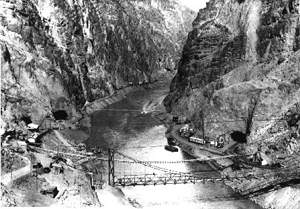
Before construction began, the mighty Colorado had to be diverted so workers could have access to a dry river bed. Four tunnels were driven through the canyon walls, two on each side, and the river funneled past the dam site. Because the dam needed to rest tightly against the canyon walls, men called “high scalers” were lowered over the rim in safety belts or boatswain chairs to drill and chip away any loose rock. In the river bed below, huge power shovels gulped up the mud and silt until reaching solid bedrock. Abutments had to be shaped and cuts made in the canyon walls to ensure the dam could carry the expected load of more than 41 billion tons. Because engineers wanted a single concrete mass, the design called for a series of vertical columns, an estimated 215 of them, each constructed block by block, the concrete poured into square forms varying in size from 25 to 60 feet square. Each block interlocked with the next by vertical and horizontal keyways, like a Lego set.
Buckets of concrete were hoisted by one of five 20-ton cableways strung from canyon rim to canyon rim. During the summer, as each section was poured, it was the sole task of 20 men to keep the concrete moist by spraying the surface with water. Inside each block, the artificial cooling system first tested at Owyhee was at work, as well. Thus was Hoover Dam, the greatest engineering achievement in Reclamation’s history, built concrete block upon concrete block until the last bucket was poured on May 29, 1935. Water had begun to back up into Lake Mead the previous February when a great steel bulkhead in one of the original diversion tunnels was lowered. The tunnels had been plugged at strategic places and now played a key role in funneling water to the intake towers.
Today, as then, electrically operated hoists atop the intake towers raise and lower gates below, releasing water from the reservoir. The water rushes in through headers and down huge pipes called penstocks to the powerhouse, where water flowing at the rate of 2,000 to 3,000 cubic feet per second operates the 17 main turbines that spin the generators that create electricity. When the first hydroelectric power surged out of Hoover’s Dam powerplant, it raced on its way to Southern California through a transmission line built by the City of Los Angeles. Water for irrigation found its way to South California’s Imperial and Coachella valleys through the All-American Canal. If an emergency warrants, a series of pipes known as the outlet system can bypass the turbines and divert water into the river channel downstream. In addition, two spillways, 27 feet below the top of the dam, stand ready to send any water reaching that high into tunnels that connect to two of the original diversion tunnels.
Following all the years of experimentation and learning, Hoover Dam was the outcome: the ultimate arch-gravity dam designed and built using the trial-load method. As the tons of water in the reservoir push horizontally against the dam’s great arch, the canyon walls push back, squeezing the concrete in the arch and making the dam rigid. Meanwhile, the great weight of the concrete, stacked in vertical columns, pushes the structure down, countering the net force of tons of water pressing on its side. With its concrete base a full 660 feet thick, the length of two football fields, Hoover’s design actually was conservative when it came to safety; so massive is its gravity profile, Billington and Jackson write, that designers “neglected to make essential use of the arch effect.”
In addition to innovations in design and construction, Hoover Dam marked a crossroads in the direction of the Bureau of Reclamation. Unlike previous dams, a principal benefit of Hoover was the hydroelectric power it created and transmitted to Southern California, Arizona, and Nevada. In coming years, Reclamation’s dams would do far more than supply water for irrigating the arid West; they would generate hydroelectric power, deliver reliable and clean water supplies to municipalities and industries, regulate river flows for navigation, and protect lives and property from floods. Importantly, the sale of electricity provided revenue to pay for other large Reclamation projects, including Grand Coulee on the Columbia River in Washington.
As Reclamation studied what kind of dam to build on the Columbia in eastern Washington, questions centered on whether to design a high or low dam, and whether to make it a gravity dam or a multiple-arch. Costs favored a low, multiple-arch dam, meaning a dam made of a number of single-arches with concrete buttresses as the supporting abutments. Reclamation, Billington and Jackson write, had become “wedded to massive forms” like Hoover and concluded that it would be too difficult in the future to add on safely to the height of a low, multiple-arch dam. Thus, the Bureau of Reclamation went with a high gravity dam, Grand Coulee, which was grand indeed; it was one of the largest concrete structures in the world, standing 550 feet high, its crest stretching for nearly a mile--four times farther than that of Hoover Dam. So large is Grand Coulee that, according to the website WordIQ.com, all the pyramids at Giza could fit within its base. Grand Coulee, built from 1933 to 1941, is so massive that its reservoir, Franklin Delano Roosevelt Lake, backs upstream for more than 150 miles. While no construction features of Grand Coulee were particularly innovative, an interesting construction feature was a steel trestle built the length of the dam, over which a tramway ran, carrying buckets of concrete mixed at the site.
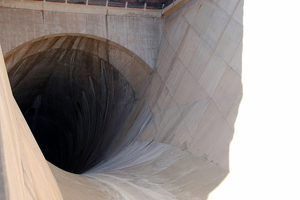
Although studies for a multiple-arch dam were not used at Grand Coulee, the design work did not go to waste. In 1936, Bartlett Dam on the Verde River in Arizona was constructed as a multiple-arch dam, the only major one ever built by the Bureau. In 1938, Shasta Dam, built on the Sacramento River in northern California followed. Construction methods were nearly identical to those used at Grand Coulee. Completed in 1945, Shasta is the third largest of Reclamation’s concrete dams (behind Hoover and Grand Coulee).
In the boom years following World War II, the Bureau of Reclamation quickly built many more large dams. The first to rise was Hungry Horse, a concrete arch dam begun in 1948 on the South Fork of the Flathead River in Montana. Because several faults were present in the excavated area where the dam was to be built, engineers used an “unusual foundation treatment” for the first time, which involved washing out clay and backfilling with grout. Into the late 1950s and 1960s the Bureau of Reclamation would continue to find new and better methods for evaluating foundation conditions, as well as seismic stability.
New concepts in arch design led to construction of Reclamation’s first double-curvature dam, Morrow Point, completed in 1968 in Colorado’s narrow Black Canyon of the Gunnison. As the first, and only, Reclamation dam with an underground powerplant, Morrow Point involved engineers in extensive geologic examinations, which included the use of television to explore drill holes. Morrow Point was a component of the last major dam building project undertaken by the Bureau of Reclamation, the Colorado River Storage Project, which would see the likes of Glen Canyon Dam on the Colorado and Flaming Gorge on the Green River in eastern Utah, both completed in 1964. At Glen Canyon, engineers went back to the thin arch design first used at Pathfinder Dam fifty years before. As Billington and Jackson write, Glen Canyon “certainly represents a move beyond the massive curved gravity form used for Hoover Dam.” Flaming Gorge, also of thin arch design was the last of Reclamation’s major dams to be built on the main stem of the Colorado River.
In 1968, the last of Reclamation’s major projects was authorized under the Colorado River Basin Project Act. Today, with the West’s rivers and streams extensively developed, the era of large dam construction is over. The last of Reclamation’s major authorizations is near completion, the Animas-La Plata Project, built in southwest Colorado and northwest New Mexico to fulfill a water rights settlement with the Ute Mountain Ute and Southern Ute tribes. But that doesn’t mean Reclamation’s engineering work is done. Following the failure in 1976 of the Teton Dam in Idaho, the Federal Government issued guidelines for dam safety. Reclamation’s dam safety and maintenance programs are ongoing, as well as the construction of projects to supply potable water (known as culinary water) to rural areas.
Advancements in engineering are not all that has changed since the Bureau of Reclamation was established in 1902. Before the age of computers, engineers did structural computations by hand, using mechanical calculators, compasses, and topography maps. But long before computers were a household item, the Bureau of Reclamation, beginning in 1957, used one of IMB’s first computers, the IBM 650, to develop a series of computer programs to do their trial-load studies. By 1967, the Bureau of Reclamation, headquartered in Denver, had a daily shuttle that took computer punch cards to what is today the National Bureau of Standards in Boulder to be read. Out of these early efforts came the sophisticated computer systems and analytical models of dam construction in use today.
Visit the National Park Service Travel Bureau of Reclamation's Historic Water Projects to learn more about dams and powerplants.
Last updated: January 13, 2017
